
Wooden Serving Trays
Locally procured, locally craftedHand-crafted using good quality food grade hardwoodLong-lasting, reusable, durable and bio-degradableEasy to use and easy to cleanSafe for human health as wood is naturally antimicrobialAn assortment of wooden serving trays to chose from Our handcrafted wooden serving trays can not only be used for serving purpose but they are also considered as items of home décor because of their unique and superior craftsmanship. Their mélange of rusticity and modernity is the main reason for their popularity among our esteemed clients.We use wood of varied types for crafting our serving trays, like mango wood, north Indian rosewood, teakwood, acacia and hard maple. The woods we source are seasoned and all are grown in India. Their quality is unquestionable and we ensure that they continue serving you for years and don’t become a liability for you. We care for our creations and our craftsmen handcraft them with utmost diligence. The trays are carefully hand polished with sandpaper to give them a smooth and even texture; during their fabrication special care is taken so that they don’t have any sharp edges, so when you hold them, you get the feel of that dedication with which they’re created. These elegant looking trays are fitted with sleek and stylish wooden or rope handles on both side that are ergonomic and easy to hold, so the question of discomfort while you carry food or drinks in them is beyond question.These serving trays are a good investment and would last you a lifetime if handled and cared for properly. You can put them to use for carrying food, beverages and other things around your home, and even use them as a graceful base for displaying your home décor items like brass or bronze statuettes and showpieces, terracotta figurines, stone statues etc. They look wonderful anywhere you keep them at home, be it in your bedroom or in you drawing room, your dining area or kitchen, these wooden trays add to your style statement and enhance the aesthetics of your interiors. They are able to withstand all heavy-duty activities and are equally suitable in commercial environments that demand sturdiness and durability. Furthermore, we also ensure that the wood on the sides of our trays are high enough to accommodate anything that’s slightly bulky which prevent them from slipping and falling off.These trays are not to put in ovens, or exposed too much in direct sunlight or else the wood might fade and lose its lustre. Similarly soaking in detergent water or cleaning with bleach is absolutely not advisable. We are not in favour of polishing these serving trays as synthetic wood polishes are not safe for humans, rather we encourage you to wipe them with soft, clean cloth and then apply some natural oil to nourish the wood.Our trays come in a variety of shapes and sizes so there’s one for everyone! We have rectangular, square, oval, round, boat shaped, cinnamon shaped serving trays that can be used for various purposes and on different occasions. You’ll need them during breakfast, during visits by guests and loved ones, during kitty parties and even during your kid’s birthday parties. Their appeal is due to their premium yet natural look and smooth texture; for everyday use like serving all kinds of beverages and snacks, these trays are just awesome. Serve freshly baked cakes, breads, pastries, cup cakes in these trays and your little ones would love them all the more. They can be perfect gifts for anniversaries, marriages, housewarming and birthdays, Christmas, Thanksgiving, Valentine’s Day, or Easter. SIZE: 16 inch L x 12 inch W x 2 inch H15.7 inch L x 11.8 inch W x 2 inch H13 inch L x 10 inch W x 2 inch H12 inch L x 12 inch W x 2 inch H9 inch L x 9 inch W x 2.5 inch H7 inch L x 7 inch W Lx 2.5 inch H5 inch L x 5 inch W x 2.5 inch H
Material : Wood
Usage : Homes, Hotels, Restaurants
...more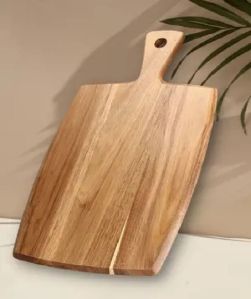
Wooden Chopping Board
Locally procured, locally craftedHand-crafted using good quality food grade hardwoodLong-lasting, reusable, durable and bio-degradableEasy to use, easy to clean and care forSafe for human health as wood is naturally antimicrobialAn assortment of wooden serving boards to chose from Wooden: North Indian Rosewood & Mango wood SIZES: 16 Inches L x 12 Inches W x 0.5 Inches Thick17 Inches L x 7 Inches W x 0.5 Inches Thick17 Inches L x 6 Inches W x 0.5 Inches Thick17 Inches L x 5 Inches W x 0.5 Inches Thick Like our cutting boards, we have different varieties of serving boards, that too of different colours, sizes and shapes. They can be put to use for serving as well as for cutting, chopping and julienning. These serving boards are known for their sturdiness and durability and are ideal for serving fruits, olives, nuts, sushi, pizza, rolls, breads, jams and jellies, sandwiches, cheese, appetizers and meat preparations to your guests. Our boards are modern looking and offer that touch of finesse to your kitchen. These serving boards have a fine texture and have a premium look. So when you serve your special delicatessen on these serving boards, they become all the more presentable and palatable for your friends and family. Along with north Indian rosewood and acacia, we also use mango wood for making our serving boards. All serving boards we make are hand curved from a single piece of wood so that they have no joint or cut marks; this gives uniformity in their texture. Our skilled craftsmen smooth them using sandpaper, giving them that touch of elegance and refinement. All cutting boards are fitted with easy-grip handles with a hole on the top for easy hanging on the wall. Durable, yet easy on knives, our boards are resistant to deep gouging. They are sturdy, easy to use and can be cleaned easily as well. They are reversible meaning both sides of these boards can be used. Both the surfaces have a wide and smooth texture. Our serving boards are free from any sort of glue and harmful or toxic finish; hence they are 100% safe for you and for your loved ones. With proper usage and care, they’d last a lifetime. You can even gift them to your friends and family members on birthdays, weddings, housewarming parties, Mother’s Day and they’d cherish the gift To clean them use warm water and mild dishwashing soap, and then let them out to air dry. Do not leave your wooden serving board soaked in water for long duration as that would adversely affect them, causing them to soften and rot. Do not put them in dishwashers. After they dry out, apply some natural oil, like coconut oil on them and store them in an upright position. Wooden: North Indian Rosewood & Mango wood SIZES: 16 Inches L x 12 Inches W x 0.5 Inches Thick17 Inches L x 7 Inches W x 0.5 Inches Thick17 Inches L x 6 Inches W x 0.5 Inches Thick17 Inches L x 5 Inches W x 0.5 Inches Thick
...more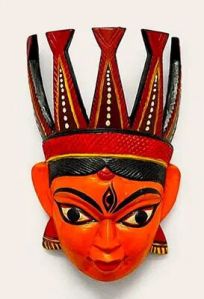
wooden masks
Kushmandi in Dakshin Dinajpur district, located in the province of West Bengal, India is the main centre of exquisite wooden masks which are known as Kushmandi masks or Gomira masks. The tradition of these brilliant looking Gomira masks is believed to be 300 years old; some craftsmen believe that the dance form is as old as the beginning of the KaliYuga. It’s believed to have originated from the Mahayana Buddhism. Ceremonial dance wearing masks is common in Buddhism. Some also believe that the Gomira dance form, also called as Mukha Naach or Mukha Khel draws inspiration from local animist cults of the tribal communities residing in this region for centuries. These flamboyant wooden masks are fully handcrafted by our local artisans that hold a dominant place in Gomira dance which are worn by the dancers during their performance. Gomira is a divine dance style that has two forms – Gomira and RamBanabas. These masks have big mouths that are hollow to allow the dancers to see through them while others have holes in the eyeballs or narrow openings below the eye area. The dancers who perform the Gomira dance are all males and they wear masks of characters they portray; the characters can be both male and female. In most of the cases the artists who make masks are the dancers themselves; our artists are the true virtuosi whose multifaceted talents get an expression thorough their transcendental Gomira dance performances.For our artists, Gomira masks are not just a work of art but they consider that the masks are a way of expressing their devotion and veneration towards Divinity; for them these masks are a source of luck and prosperity to their families. Unlike Chhau masks of Purulia district of West Bengal that are made of paper pulp and are light in weight, the Gomira or Kushmandi masks are quite weighty as they are made entirely of wood. Our artists’ favourite wood is gamhar or Gmelina arborea and they also use neem or Azadirachta indica for crafting the Gomira masks. Mahogany and mango woods are also used depending on the availability. The wood to be used for making the masks is first soaked and then they are dried in the sun. The artists always ensure that they season the wood beforehand as this would make the wood crack resistant and would also prevent any sort of infestation thus making the masks last for a longer duration of time. To make the wood to termites and bugs, the artisans treat it with boric acid, borax and copper sulphate in a proportion of 3:4:5. After seasoning and chemical treatment, the artists cut it and curve motifs and designs on the block of wood. For painting the masks the artists generally use natural dyes – from teak red dye is obtained, beans gave green dye, violet is obtained from blackberry, for black colour the artists took help from neem tree. Nowadays the artisans also rely on chemical based paints and dyes. The artists use hammer and chisel to curve motifs on the wooden block to give it the required shape. For finer details, different types of hammers and chisels are used to provide the desired look and shape to the mask. The back of the mask is curved out scrupulously by the artists and then it’s sanded by hand. Finally the artists paint it with their desired colours. On an average, our artists take 3 to 4 days to complete a mask however much depends on the size and the complex motifs of the mask which might increase the production time. The responsibility of mask making is shared by the all the family members who whole-heartedly participate to make them although the primary responsibility of cutting and curving are done by the male artists. The entire credit goes to our artists whose commitment and devotion towards the art has kept it alive. Currently around 250 to 300 artists are engaged with this art.The word Gomira has been derived from the village deity named Gram Chandi. The deity is considered to protect the village from ominous forces. The craftsmen making the Gomira masks are the ardent worshippers of Adi Sharkti who is considered the Supreme Goddess according to the Shakti sect of the Sanatana Dharma. Each village has a dedicated temple devoted to a Goddess. The masks are kept before the Goddess during Nishi Puja that takes place during midnight before the dance is performed the next day. Before commencing with the performance, the dancers worship the masks to show their reverence and dedication towards the art. In a Gomira dance performance there is no vocal involvement in the form of dialogues or renditions of any sort. Hence the Gomira masks play an indispensable role during the performance and through the masks the dancers express themselves. The only musical instruments that are played during their performance are dhaak, an indigenous percussion instrument and Kashor or a bell metal plate played with a wooden stick that’s held in the right hand; instruments like Shehnai, a reed instrument of India.For the promotion of this precious art, the provincial and the central government of India have taken various initiatives for promoting the art and the artists in various ways. The artists are provided with various platforms like local, national and international exhibitions and fairs to showcase their artistic acumen; various workshops and awareness camps are organized at various levels to create more awareness among people.These beautiful wooden masks are the showpieces that would take you back in time and open up a world of imagination for you. Ideal for all locations, our wooden masks are exotic and exquisite which would draw the attention of everyone visiting you.
...more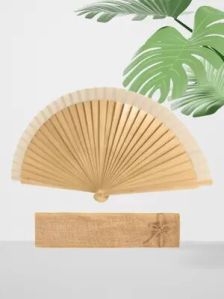
Wooden Fans With Jute Covers (Gift Item)
Locally procured, locally craftedReusable, heavy duty, 100% natural wooden/bamboo fanHand-crafted, durable, eco-friendly and biodegradableHand-held, portable and foldableImprints on jute covers made with 100% natural dyesJute covers to be hand washed in cold water and hang dry only SIZE: 50 cm x 25 cm x 37 cm 38.1 cm x 3.8 cm x 22.9 cm 10 cm x 7 cm x 5 cm Our handheld fans are made with natural wood; we use no varnish, paint of any sort or treat them with chemicals so as to ensure that they retain their natural rustic feel. Other than natural wood, we also make handheld fans made of good quality locally procured bamboo.Handmade with care and warmth by our artisans, whose adeptness give that exceptional feel to their creations, these fans are crafted specially for you and are perfect to carry during warm summer days or in parties, weddings and stage shows. Along with elegance and royalty, compactness and portability are two major highlights of this product. They fold easily and can be tucked away easily into your handbags. To store them in a proper manner, we recommend that you keep them inside our simple and classically designed drawstring jute covers that come with them. These jute bags are made of 100% natural premium quality burlap fitted with jute drawstrings. The drawstrings we used in these bags are durable and are well stitched so as to ensure easy opening and closing. NOTE: Our company provides the options for handheld natural wooden as well as bamboo fans; similarly we have the option of jute covers in natural jute colour or custom printed in various colours as per your preference. SIZE: 50 cm x 25 cm x 37 cm38.1 cm x 3.8 cm x 22.9 cm10 cm x 7 cm x 5 cm
...more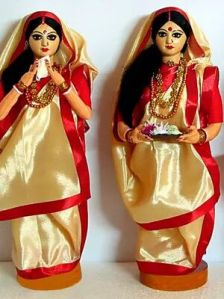
wooden dolls
Our wooden dolls are 100% handcrafted by our local artists of Nutangram, located in Bardhaman district of West Bengal which is one of the prominent locations where wooden dolls and wooden figurines are made. Bardhaman has a legacy of rich heritage and the artists, known as Bhaskar (sculptor) and Sutradhar (narrator or story teller) express themselves through their traditional art of wooden doll making. This place has resurrected the age old art of wooden doll making for which West Bengal is known for. The artist takes a single piece of seasoned wood which is then chiselled by hand and cut in a specific length. The artisan uses mango wood, bombax ceiba, goomar teak, sugar-apple wood, Alstonia scholaris wood for making these dolls.Then comes the final work of painting which the artist does with utmost meticulousness; care is taken to paint them in bright colours. These dolls have a distinctive ethnic feel which is particular to this region. It’s noteworthy that the duties are earmarked for each artisan – the men folk are assigned with the task of wood curving and chiselling which the duties for giving the final touch to the dolls like colouring are taken care of by the womenfolk of the families. They use intricate motifs and spellbinding designs to decorate their creations. Colours used are fabric colours and oil paints. The popular of the dolls that are made are a pair of owlets that has its roots in the Hindu religion. According to the Sanatana Dharma, owl is the Vahana or carrier of Mata Lakshmi, the Goddess of Wealth and Fortune. Hence the owl is revered and worshipped and the artists of Nutangram continue crafting them till this day, painting them in traditional yellow, red and green colours; black colour is used to paint the eyes and the outlines. Wooden figurines of Lord Krishna and Sri Radhika and various other Hindu Gods and Goddesses are another favourite subject of the artists. They also make wooden soldier dolls that are thought to have been introduced by the kings who ruled the Kingdom of Burdwan (1657 to 1995). Since every piece of art is handcrafted, they are genuinely matchless with an unsophisticated beauty and charm. Our aim is to be by our artists in every possible way so that they can continue their traditional art of wooden doll making for generations to come. We also request you to buy products crafted by our artists and show your patronage towards their art.
...more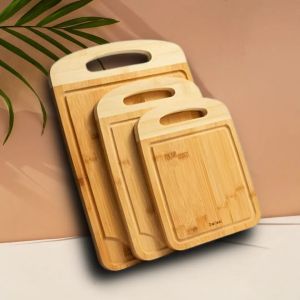
Wooden Cutting Boards
Locally procured, locally craftedHand-crafted using good quality food grade hardwoodLong-lasting, reusable, durable and bio-degradableEasy to use, easy to clean and care forSafe for human health as wood is naturally antimicrobialAn assortment of wooden cutting boards to chose from Wooden: North Indian Rosewood, Mango wood, Acacia, TeakwoodNOTE: We also manufacture cutting boards of customized sizes as per your requirement.DIMENSION: 17 Inches L x 12 Inches W x 1.2″Thick (standard size) Cutting boards are quintessential for every kitchen, be it for domestic or commercial purpose. They are ideal for chopping or julienning vegetables, or for cutting fruits cheese and breads. These hand–crafted cutting boards made with precision have a unique texture and colour that add to their elegance and charm. Wood is far and away the best material for making cutting boards. Durable, yet easy on knives, our boards are resistant to deep gouging. They have a smooth texture yet they aren’t slippery. They are sturdy and have the ability to withstand shocks. Our craftsmen prefer acacia and teakwood for fabricating cutting boards as these woods are durable and naturally resistant to moisture. Their other two choices are either mango wood or north Indian rosewood which are equally in demand by our esteemed clients. They make sure that the wood used is dried for at least 90 days and is sterilized to provide you the protection you and your family deserve. These boards are easy to use and can be cleaned easily as well. They are reversible, meaning both sides of these boards can be used. Both the surfaces have a wide and smooth texture having handles on both sides to help you lift and move them effortlessly. Our cutting boards are free from any sort of glue and harmful or toxic finish; hence they are 100% safe for you and for your loved ones. They are useful products to gift to someone you love and care for. Your hostess would appreciate this gift of yours throughout her lifetime! To prolong their lifespan, use warm water and mild dishwashing soap to clean them, and then let them out to air dry. Do not leave your wooden cutting board soaked in water for long duration as that would adversely affect them, causing them to soften and rot. Do not put them in dishwashers. After they dry out, apply some natural oil on them and store them in an upright position. We hope you’d enjoy using our product as much as we enjoy creating them. Wooden: North Indian Rosewood, Mango wood, Acacia, Teakwood NOTE: We also manufacture cutting boards of customized sizes as per your requirement. DIMENSION: 17 Inches L x 12 Inches W x 1.2″Thick (standard size)
...more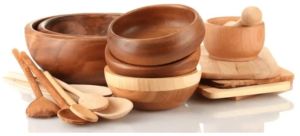
wooden cutlery
Locally procured, locally craftedHand-crafted using good quality hardwoodLong-lasting, reusable, durable and bio-degradableBad conductors of heat, so easy to holdEasy to cook, easy to clean and care forSafe for human health as wood is naturally antimicrobialAn assortment of wooden cutlery to chose from Wood: Neem wood, Mango wood, Acacia wood, Rosewood Our entire ranges of wooden cutlery items are light in weight with thick handles for easy grip. We have wooden spoons of different sizes, forks, salad forks, slotted spatula, flipping spatula, single hole mixing spoon, slotted spoon, non-slotted spoon, ladles that are made of 100% natural hardwood. They are all made from a single block of wood so that there are no joint or cut marks. Our craftsmen smooth them conscientiously with sandpaper, giving them that refined, elegant look. Frankly speaking, you’d lovingly allow them entry into your kitchen and use them for your everyday cooking. They are totally safe to use and works great with non-stick, stainless steel, cast iron or ceramic cookware. To prolong their lifespan, use warm water and mild dishwashing soap to clean them, and then let them out to air dry. Do not leave your wooden utensils soaked in water for long duration as that would adversely affect them, causing them to soften and rot. Do not put them in dishwashers. After they dry out, apply some natural oil on them, and they’d continue serving you for years to come. Wood: Neem wood, Mango wood, Acacia wood, Rosewood
Packaging Type : Paper Box
Application : Home
...more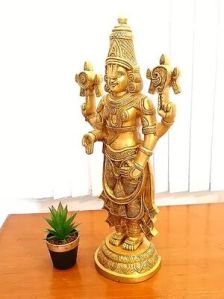
Vishnu Ji Brass Figurines
India has the reputation of manufacturing some of the finest, unique and exclusive handicrafts in the world. Art and metal craft has been a significant and inseparable part of the Indian culture. For thousands of years, our Indian craftsmen and artisans, through their creative acumen, perseverance and devotion have been producing some of the finest quality of hand-crafted items; our highly talented craftsmen carry a rich and diverse heritage of skilled craftsmanship that gets passed on from one generation to another. This age-old traditional techniques of theirs offer uniqueness to their prized creations that are truly exclusive in themselves. Due to their undaunted efforts and the initiatives of the Government of India, the popularity of the Indian handicrafts are constantly on the rise not only at the domestic level but also at the international level, and connoisseurs worldwide hold our artwork in high esteem. The brass art of India, like several other art forms of our Nation, holds a predominant place in the world arena. Indian produces a wide range of brass artworks ranging from decorative items like statuettes, statues, figures of deities, wall hangings, different types of figurines, jewellery and showpieces. Additionally, our artisans manufacture articles for worship (puja items) like vases, lamps, bells, incense stick holders as well as different types of utensils like plates, bowls, pots, jugs, tumblers, spice boxes, containers, woks, pans, turners, tongs or pincers, spoons, and many more. They exemplify gorgeousness, excellence and intricacy. Sculpting and engraving on brassware is a highly specialized job that requires years of patience and experience. Brass artwork including decorative items, articles of worship as well as brass utensils for everyday use in common households are also in huge demand in temples and other places of worship, in religious gatherings, in palaces and royal households which shows that brass has an universal acceptability in all strata of the society. Brass being an alloy of copper and zinc, it has a truly long life and doesn’t get degraded over time. If proper care is taken to keep them in perfect condition, brass handicraft items continue to maintain its lustre and even with prolonged usage, they tend to if have the same brilliance as they had when they were purchased years ago. Brass is anti-corrosive, but due to oxidation that takes place due to it contact with oxygen in the air, it tends to develop a protective coating called patina. This patina can be cleaned with lemon juice or white vinegar mixed with half a spoon of baking soda; mix them well and until it becomes a paste. Apply the paste with a soft cloth and wait for 10 to 15 minutes, after tat clan it with warm water and immediately wipe it dry. Once cleaned and polished, brassware regain its lustre and shine. NOTE: Our copper bottles are available in 300ml, 600ml, 750ml and 1 litre quantities. We manufacture copper bottles of original copper colour as well as customized bottles in various colours, designs and shapes as per your preference.
...more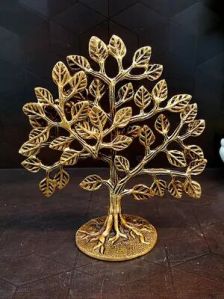
tree Brass Figurines
India has the reputation of manufacturing some of the finest, unique and exclusive handicrafts in the world. Art and metal craft has been a significant and inseparable part of the Indian culture. For thousands of years, our Indian craftsmen and artisans, through their creative acumen, perseverance and devotion have been producing some of the finest quality of hand-crafted items; our highly talented craftsmen carry a rich and diverse heritage of skilled craftsmanship that gets passed on from one generation to another. This age-old traditional techniques of theirs offer uniqueness to their prized creations that are truly exclusive in themselves. Due to their undaunted efforts and the initiatives of the Government of India, the popularity of the Indian handicrafts are constantly on the rise not only at the domestic level but also at the international level, and connoisseurs worldwide hold our artwork in high esteem. The brass art of India, like several other art forms of our Nation, holds a predominant place in the world arena. Indian produces a wide range of brass artworks ranging from decorative items like statuettes, statues, figures of deities, wall hangings, different types of figurines, jewellery and showpieces. Additionally, our artisans manufacture articles for worship (puja items) like vases, lamps, bells, incense stick holders as well as different types of utensils like plates, bowls, pots, jugs, tumblers, spice boxes, containers, woks, pans, turners, tongs or pincers, spoons, and many more. They exemplify gorgeousness, excellence and intricacy. Sculpting and engraving on brassware is a highly specialized job that requires years of patience and experience. Brass artwork including decorative items, articles of worship as well as brass utensils for everyday use in common households are also in huge demand in temples and other places of worship, in religious gatherings, in palaces and royal households which shows that brass has an universal acceptability in all strata of the society. Brass being an alloy of copper and zinc, it has a truly long life and doesn’t get degraded over time. If proper care is taken to keep them in perfect condition, brass handicraft items continue to maintain its lustre and even with prolonged usage, they tend to if have the same brilliance as they had when they were purchased years ago. Brass is anti-corrosive, but due to oxidation that takes place due to it contact with oxygen in the air, it tends to develop a protective coating called patina. This patina can be cleaned with lemon juice or white vinegar mixed with half a spoon of baking soda; mix them well and until it becomes a paste. Apply the paste with a soft cloth and wait for 10 to 15 minutes, after tat clan it with warm water and immediately wipe it dry. Once cleaned and polished, brassware regain its lustre and shine. NOTE: Our copper bottles are available in 300ml, 600ml, 750ml and 1 litre quantities. We manufacture copper bottles of original copper colour as well as customized bottles in various colours, designs and shapes as per your preference.
...more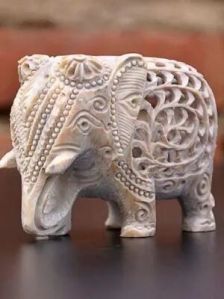
Stone Artwork Figurines
Locally procured, locally craftedExquisite, superior quality stone selectionCarefully hand-crafted with dedicationAn unmatched variety of stone artwork products to chose from100% satisfaction or our valued clients Our handcrafted sculptures are made of white marble, black marble, sandstone, jade, kadappa stone, pink stone, red stone; they are used for making figurines of gods and goddesses, small bowls used for keeping sandalwood paste, and other articles used for religious purposes during pujas; additionally, it’s used in the construction of temples where even deities are made of marble. Stone figurines and sculptures are quite popular for home décor; there are innumerable varieties of stone art items to choose from. When you decorate your interior with these sculptures, they transform the entire ambience of your rooms, creating an elegant, graceful, refined and holistic atmosphere. Stones are even used in curving cookware and kitchenware like cooking vessels (Kalchatti) and containers made of soapstone, utensils made of habur stone, marble rolling board and rolling pin, mortar and pestle, chopper board, stone pots and pans to name a few. All our stone handicraft products are made of stones that are meticulously selected and our artisans work on them to give them the desired shape and finish they deserve. The craftsmanship of our stone handicrafts is unparallel and owning them is truly a matter of pride and a feeling of satisfaction. They can be a These intricately crafted artworks are a classic example of the refinement and finesse of Indian stone handicrafts.
...more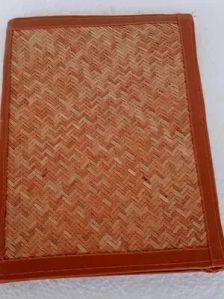
Sitalpati Mats
In India, mat weaving is an art that has been in practice for centuries. Our traditional texts like the Vedas and Upanishads have the mention of Rishi or sages who used Kushasana or a mat that’s woven with a type of grass. Sital Pati is one of the finest and unique handicraft products of Rural Bengal. It is an integral part of the handicrafts that are produced in the eastern provinces of West Bengal, Assam and Tripura and exhibits the artistic acumen and craftsmanship of the artists of this region. It is woven from green cane slips that are locally known as mutra (Maranta Dichotoma); this type of cane is produced in abundance in this part of the world. There might be a possibility that the word mutra is derived from the Bengali word mukta meaning pearl due to the resemblance of its seed with pearls. The stems of these canes are used to make Sital Pati mats. After harvest, these cane slips are soaked in water and then they’re sliced lengthwise into very fine strips. This process of slicing them is called holui. Sital Pati making process requires the cane slips to be soaked in rice water for a day and then the same rice water is used to boil them. They are then washed in water and laid out in the sun for drying. After they dry, they are left outside in the open throughout the night. The dew that forms on them overnight helps in improving their quality and makes them even smoother in texture. Another process of preparing the cane slips is to soak them in water for 6 to 7 hours only and the process of boiling them is not carried out. Next comes weaving which is done mainly by the womenfolk, and the technique they use for weaving is called Muri Bandha. The artists use both straight and diagonal patterns and create beautiful geometric patterns with the help of white slips (sada sital) and red slips (lal sital). The diagonal weaving pattern is considered more complicated compared to the straight ones; the craftsmen come up with intricate motifs of animals, birds, fishes as well as religious symbols, e.g. Pitcher of Goddess Lakshmi. Nowadays Sital Pati with intricate designs or Bhushnai are getting rarer and rarer day by day as exceptionally fine cane slips are needed to conceive them. In general the artists use natural and vegetable dyes for dyeing their creations. During the present times they have also started using Azo-free dyes that adding a touch of vivacity to their masterworks. The pièce de résistance is undoubtedly their genius to create such phenomenal heirloom chef-d’œuvre that has earned the admiration of connoisseurs the world over!This handicraft product involves the entire family and is meant for everyday use. Our country always had a tradition of making utilitarian articles with raw materials that can be procured naturally and are readily available locally. This shows that for centuries the Indian society has habitually been nature-centric and has an intimate bond with Mother Nature.The word Sital in the Bengali language means cool and Pati means mat. Sital Pati is mainly used for sitting, resting or sleeping. When sat or slept on it an authentic Sital Pati would make a person feel cool and relaxed. The quality of the Pati can be determined by its smoothness, glossiness and its thickness. Due to their cool nature they are also used as decoration for hanging on doors and windows during summers.It’s worth mentioning that Sital Pati come in various types based on their quality. These are Chotar Pati, Mota Pati, Shital Pati and Seddo Pati. Apart from quality, quantity, textures, weaving patterns etc are the reasons behind the differences among the Sital Pati. Among all types of Pati, the most valuable is the Sital Pati and the cheapest one is called Buka Pati. Shital Pati is is considered the best of all varieties because of its supreme quality and the thickness of bark which is used to weave it. It is much more flexible than the other varieties. It is the most sought-after variety due to its smoothness and glossy texture. Shital Pati is whitish in colour and thinnest among all its peers.Cooch Behar, located in northern part of the province of West Bengal is the most renowned centre for the production of Sital Pati mats other than Tripura and Assam. Around 14000 families are engaged in the art of weaving Sital Pati in Cooch Behar district where a museum exhibiting different types of Sital Pati mats has been set up in a place called Ghughumari. In addition, the Rural Craft Hub project sponsored by UNESCO has recognized Sital Pati art as an “Intangible Cultural Heritage”.This art has dramatically changed the livelihood of the artists and now a substantial improvement can be seen in their living standard. The government of West Bengal along with the Government of India are encouraging more and more villagers to take up this art through training programmes. Diverse schemes for providing financial assistance to the artists have been introduced to inspire our craftswomen and craftsmen. Handicraft fairs and exhibitions are organized both nationally and internationally in which our artists participate to have a better understanding of the market requirements as also to showcase their creations. These exhibitions offer an excellent opportunity for establishing new contacts and give them a true exposure to the outside world.Sital Pati mats are perfect to be carried to your beach parties or for relaxing in your garden or terrace with friends and family members. Hang them to your walls and windows and enjoy their natural beauty. Due to their naturally cool nature, these mats are 100% natural products which make them unique and exclusive. Resting on them would be an entirely different experience for you.
...more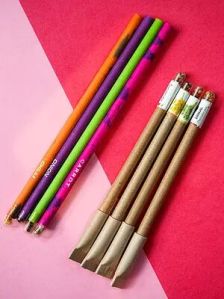
Seed Pens
Locally procured, locally crafted100% environment-friendly hand-made paperExquisite, innovative and bio-degradablePens/pencils with organic seeds insideCrafted with affection by our differently-abled artistsA wide variety of hand-made paper products to chose from Our seed pens and pencils are made with 100% handmade paper that’s produced naturally. We believe in giving back to Mother Earth and it’s our humble initiative to make our planet habitable and green for the future generations. It’s with this thought in our mind that we envisaged the idea of crafting our pens and pencils with 100 % handmade paper. These pens and pencils are a perfect alternative to plastic ball-point pens that not only detrimental to the environment but they also increase the amount of plastic waste on the planet. The body of these pens and pencils are made of handmade paper and only the refill is the only plastic material that’s used in them. These pens and pencils write well as they’re fitted with free-flowing, smooth refills, so that your writing experience is flawless. At the top of every pen and pencil we’ve put a seed of a vegetable or a fruit which you can plant in your planter or in your garden after they’re used. Water them and they’d grow into a sapling. Ensure that they get proper sunlight from time to time. You have a wide range of colours to choose from and we even use fluorescent coloured papers to make them look more attractive and appealing. To make your writing experience memorable, we used 3 different types of refills in our pens – gel refills, pinpoint refills and round tip refills. You can choose whichever you like. As for our pencils, we use bonded leads in our handmade paper pencils. These leads are glued from the top to the bottom so that they don’t get broken easily. This would give you hassle-free writing experience when you or your kids use during their daily activities. To match them, we even have a wide range of paper binders and folders that you can carry along. Our pens and pencils are customizable and in case you want some photo, company logo or a message on them, we can do that for you as well. We even make pens with steel clips so that you can keep them clipped to your pocket while you go to your workplace. Our handmade paper pens and pencils are a veritable way for inculcating the habit of planting trees and creating awareness on the environment in our little ones.
...more
Seashell Table Lamps
These conch shell table lamps are for the sophistiqué who appreciates the finer things in life. Placing them on your desired location, e.g. home, office, restaurant can help create an avant-garde ambience; they would unquestionably catch the eye of anyone visiting you. Our seashell table lamps are made of 100% natural seashells that come in different varieties, shapes and sizes. Choose the one that you prefer for giving your surroundings that subtle feel of elegance, grace and sublimity. These lamps are the best gifts that you can give to anyone whom you love and admire. There’s no denying the fact that your exquisite gift would surely make any special occasion even more special. Please go through our assortment of seashell table lamps to pick the right one for you and your loved ones.
...more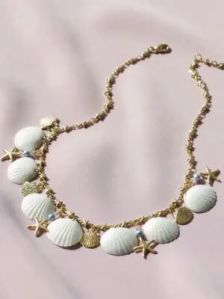
seashell ornaments
Seashell jewellery is in vogue and is one of the major varieties of non-precious jewellery. Our seashell artisans are village dwellers for whom this art is an heirloom; their constant endeavour is to keep this declining traditional art alive. The magical and mystical touch of our artisans gives birth to our superlatively enthralling creations of seashell ornaments and jewellery. Our array of different varieties of seashell jewellery has a touch of the Orient in them and would fascinate you due to their intricate designs and patters that are unique to India. Every piece of jewellery you buy is handcrafted so each of them is unique in itself. The seashells procured and used by our artisans to produce every piece of jewellery are 100% genuine so you know that what you purchase is worth every penny that you spend.Adorn yourself with our range of seashell jewellery on occasions like weddings, parties, marriages, during festivals as well as religious celebrations. This type of jewellery goes equally well as casual wears while you’re going to your workplace, or when going for soirée, kitty party and so on. Our assortment of unique and adorable seashell jewellery is a wonderful item that you can gift to your friends and family. Apart from jewellery, our artisans craft different types of showpieces that you can purchase to decorate your home with, be it in your study, living room, bedroom or your office, these showpieces complement to the overall aesthetics of the surrounding.Every time you buy our pieces of seashell artwork, you’re contributing towards the financial and social betterment of our artisans. This social contribution of yours would help them keep this ancient art alive. Take a look at our entire spectrum of jewellery and showpiece items
...more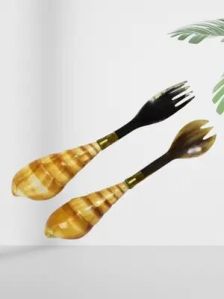
Seashell Forks And Spoons
Our seashell artist is a state award winner who’s earned his reputation for his impressive craftsmanship on seashells. He’s held in high esteem for his impeccable creations of seashell artwork the art of which he’s inherited from his father. The spoons, forks including various other showpiece items are all crafted by our master artist. These cutleries are a valuable addition to your existing cutlery sets. Use them while serving eatables during ceremonies, parties or gatherings and your guests would reciprocate your superior choice with praise and admiration. Below is our diverse selection of seashell cutlery items for you.
...more
Sabai Grass Handicrafts Basket
The Sabai Grass art is as old as time itself and has been an integral part of the culture of the provinces of West Bengal and Odisha. In West Bengal this type of grass can be found in abundance in forest areas of Paschim Medinipur, Purulia amd Bankura districts. In Odisha, Mayurbhanj district is known for its exquisite Sabai Grass handicraft products.The botanical name of Sabai Grass is Eulaliopsis banana is a type of tufted perennial grass in which the leaves are basal in general; locally known as Babui Ghash or Bhabar Ghas in Hindi, they grow in the wild and are quite erect and rigid in nature. They are effortless to work with and can be dyed easily too. For those who’re unaware, Sabai Grass is used as a major raw material and comes 2nd after bamboo for making paper pulp in India. They are widely used in making ropes and in the present times are also used to manufacture home décor and utility products.This art has a tremendous involvement of the womenfolk of these regions and who are the key contributors in the cultivation and production of Sabai Grass products. A sizeable population of womenfolk in villages of these provinces are engaged in the cultivation, processing and manufacturing of products made of Sabai Grass. The women artisans collect this grass and thrash them on the ground; this process renders the grass soft and flexible making them more manageable for twisting and twining. Afterwards they soak the grass and wash them. Then they let the grass dry in the sun. Once the grass gets completely dried, they are twisted in bundles to make ropes. These ropes are sold in the local village markets. The craftswomen also make diversified products with Sabai Grass and sell them to earn a living. They twist the Sabai Grass to use leaves of dry palm leaves for binding; our craftswomen also take the help of frames to give a proper shape to their products. Beautiful and elegant mats, coasters, trays, flower vase, planters, laundry baskets, storage baskets with lid, lamp shades, small bags, wall hangings, multicoloured storage boxes are crafted by our local artists that has a feel of ethnicity and showcase their adroitness. They have even gone to the extent of handcrafting cots and sofa sets out of Sabai Grass that are truly astounding! Since Sabai Grass can be dyed easily, our artists dye them using natural dyes to give a flamboyant look to their creations; at times Azo-free dyes are also used that are eco-friendly and are not harmful for humans as they don’t contain harmful compounds like nitrogen or bleach. For dyeing, firstly colour is mixed in the required quantity in boiling water, once the colour dissolves completely in water, the bunches of grass are soaked in it and later dried in the sun. Around 4000 of such artists are associated with the manufacturing of Sabai Grass handicrafts. This has created new opportunities for income for them and has helped them become self-sufficient and self-reliant. Our women artists now feel more empowered and their families acknowledge their valuable contribution towards the betterment of their financial conditions. A lot of involvement, hard work and dedication are required in producing these beautiful artistic products which are gaining in popularity day by day at home as well as overseas. Our women artists take active initiative in attending various training programmes organized by the state and the central government agencies and also display their incredible artworks in various fairs and festivals held at the local, national and global levels.Being a natural fibre, Sabai Grass is environmentally sustainable and is a bio-degradable making them an ideal choice for those who care for the well being of our beloved planet and prefer leading a green way of living. These handcrafted products are time tested and are known for their endurance. They can be used in whichever way you feel like, at home, in your home office, in eateries, boulangeries or restaurants, they feel at home in any ambience. Make an entry in the world of naturally made products and make them a part of your daily life; decorate your interiors with Sabai Grass decorative items or gift them to your loved ones for creating more awareness about these sublime gifts that Mother Earth has endowed us with.
...more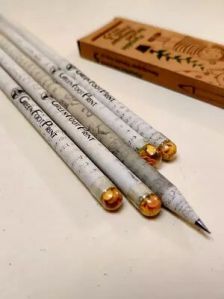
Pencils Of Handmade Natural Paper
Our seed pens and pencils are made with 100% handmade paper that’s produced naturally. We believe in giving back to Mother Earth and it’s our humble initiative to make our planet habitable and green for the future generations. It’s with this thought in our mind that we envisaged the idea of crafting our pens and pencils with 100 % handmade paper. These pens and pencils are a perfect alternative to plastic ball-point pens that not only detrimental to the environment but they also increase the amount of plastic waste on the planet. The body of these pens and pencils are made of handmade paper and only the refill is the only plastic material that’s used in them. These pens and pencils write well as they’re fitted with free-flowing, smooth refills, so that your writing experience is flawless. At the top of every pen and pencil we’ve put a seed of a vegetable or a fruit which you can plant in your planter or in your garden after they’re used. Water them and they’d grow into a sapling. Ensure that they get proper sunlight from time to time. You have a wide range of colours to choose from and we even use fluorescent coloured papers to make them look more attractive and appealing. To make your writing experience memorable, we used 3 different types of refills in our pens – gel refills, pinpoint refills and round tip refills. You can choose whichever you like. As for our pencils, we use bonded leads in our handmade paper pencils. These leads are glued from the top to the bottom so that they don’t get broken easily. This would give you hassle-free writing experience when you or your kids use during their daily activities. To match them, we even have a wide range of paper binders and folders that you can carry along. Our pens and pencils are customizable and in case you want some photo, company logo or a message on them, we can do that for you as well. We even make pens with steel clips so that you can keep them clipped to your pocket while you go to your workplace. Our handmade paper pens and pencils are a veritable way for inculcating the habit of planting trees and creating awareness on the environment in our little ones.
...more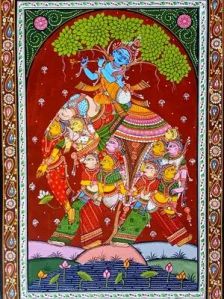
lord krishna Patachitra Painting
Patachitra art form is believed to have originated as early as the 10th or 11th century and is one of the oldest and most famous living art forms. This style of painting is practiced majorly in the province of West Bengal. Other than West Bengali, Odisha is another province where this art is widely practiced. In West Bengal the districts of Purulia, Birbhum, Bankura, and Paschim Mednipur are the main centres of this enthralling art form.The name Patachitra or Pattachitra has evolved from the Sanskrit word Patta meaning cloth, and Chitra meaning picture. This folk style of painting that is traditionally done on cloth scrolls is practiced by the artists who call themselves Patua or Chitrakar in West Bengal. Pattua is a community of artisans who are raconteurs who had been practicing a unique art of storytelling that’s accompanied by showing beautiful paintings and songs. The Chitrakar or the painter while narrating the stories gradually unfurls the paintings to make the entire performance more enticing. Many connoisseurs, artists and researchers have been fascinated by the Patachitra art and it has been considered as an acclaimed style of painting both nationally and internationally. Some compare this age old approach of storytelling with modern day comic strips. The songs sung during the storytelling are called Pater Gaan. The Patua or Patachitra artists travel from one village to another showing their Patta and narrating its tales to the audience with the help of songs in a very lucid manner so that their message has a wider reach in the rural society. Stories from the past including religious like the Ramayana, the Mahabharata,Mangalkabya, Krishna Leela, Behula Manashamangal or mythological, and those of valour and sacrifice are narrated by the Patachitra artists. They also enlighten the rural communities by taking up burning social issues like intoxication and other social evils and narrating them with the help of their Patta. Like most of the other art forms, this art form too is a traditional one and the knowhow gets communicated orally from one generation to the next.The major characteristics of the Patachitra art of West Bengal are the usage of bold colours and strokes while painting them; for the environmentalist in you, it’s worth noting that Patachitra artists use natural colours sourced from local sources different types of fruits, flowers and stones to paint their Patta. Patua and Chitrakar (Patachitra artists) are highly skilled and spend a lot of time in drawing and painting their Patta since such attractive masterpieces require a lot of perseverance and meticulousness to create. The creativity of a Chitrakar is not confined to cloth and canvas but they also express their talents by painting beautiful murals on the outer walls of their abodes.Their exclusive use of naturally sourced vibrant colours make their art form look unique and more appealing.Patachitra can be categorized in two different types – Ekachitra or Choukapatta and Dighal Patta. In Ekachitra, the Chitrakar narrates one continuous story that’s in the Patta which comprises of many small squares or Chouka. In Dighal Patta, the Chitrakar or the Patua narrates stories that are intricately interwoven having many sections or episodes. In Dighal Patta unlike Ekachitra there are several paintings for which it’s also called Jorano Patta due to their long length having a close resemblance with scrolls. The Patta scrolls come in varied sizes – they can be from 1 to 1.5 feet in width and 3 to 25 feet in length. The longer the story, the longer is the Patta. Dighal Patta has two bamboo sticks attacked at both ends so that they can be easily rolled up for easy carrying and storage. The rolling of the Patta is done from the bottom stick. Some historical sources reveal the Patua community playing the role of secret agents; it’s believed that during the rule of the mighty Maurya dynasty, the Patua or the Chitrakar served as informers for the military; they played the role of secret emissaries apart from being edutainers transmitting secret information through their storytelling.At present the central and the state governments are patronizing our ancient art forms and encouraging our artists to reach out to the outside world by fostering awareness about their artistic genius.Bring home Pattachitra paintings and add a flavour of India to your interiors. They would surely liven up your drawing room or your bedrooms with their intricate designs and radiant colours.
...more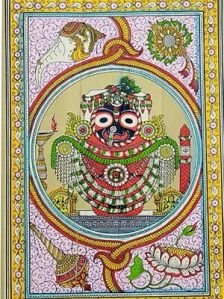
Lord Jaganath Ji Patachitra
Patachitra art form is believed to have originated as early as the 10th or 11th century and is one of the oldest and most famous living art forms. This style of painting is practiced majorly in the province of West Bengal. Other than West Bengali, Odisha is another province where this art is widely practiced. In West Bengal the districts of Purulia, Birbhum, Bankura, and Paschim Mednipur are the main centres of this enthralling art form.The name Patachitra or Pattachitra has evolved from the Sanskrit word Patta meaning cloth, and Chitra meaning picture. This folk style of painting that is traditionally done on cloth scrolls is practiced by the artists who call themselves Patua or Chitrakar in West Bengal. Pattua is a community of artisans who are raconteurs who had been practicing a unique art of storytelling that’s accompanied by showing beautiful paintings and songs. The Chitrakar or the painter while narrating the stories gradually unfurls the paintings to make the entire performance more enticing. Many connoisseurs, artists and researchers have been fascinated by the Patachitra art and it has been considered as an acclaimed style of painting both nationally and internationally. Some compare this age old approach of storytelling with modern day comic strips. The songs sung during the storytelling are called Pater Gaan. The Patua or Patachitra artists travel from one village to another showing their Patta and narrating its tales to the audience with the help of songs in a very lucid manner so that their message has a wider reach in the rural society. Stories from the past including religious like the Ramayana, the Mahabharata,Mangalkabya, Krishna Leela, Behula Manashamangal or mythological, and those of valour and sacrifice are narrated by the Patachitra artists. They also enlighten the rural communities by taking up burning social issues like intoxication and other social evils and narrating them with the help of their Patta. Like most of the other art forms, this art form too is a traditional one and the knowhow gets communicated orally from one generation to the next.The major characteristics of the Patachitra art of West Bengal are the usage of bold colours and strokes while painting them; for the environmentalist in you, it’s worth noting that Patachitra artists use natural colours sourced from local sources different types of fruits, flowers and stones to paint their Patta. Patua and Chitrakar (Patachitra artists) are highly skilled and spend a lot of time in drawing and painting their Patta since such attractive masterpieces require a lot of perseverance and meticulousness to create. The creativity of a Chitrakar is not confined to cloth and canvas but they also express their talents by painting beautiful murals on the outer walls of their abodes.Their exclusive use of naturally sourced vibrant colours make their art form look unique and more appealing.Patachitra can be categorized in two different types – Ekachitra or Choukapatta and Dighal Patta. In Ekachitra, the Chitrakar narrates one continuous story that’s in the Patta which comprises of many small squares or Chouka. In Dighal Patta, the Chitrakar or the Patua narrates stories that are intricately interwoven having many sections or episodes. In Dighal Patta unlike Ekachitra there are several paintings for which it’s also called Jorano Patta due to their long length having a close resemblance with scrolls. The Patta scrolls come in varied sizes – they can be from 1 to 1.5 feet in width and 3 to 25 feet in length. The longer the story, the longer is the Patta. Dighal Patta has two bamboo sticks attacked at both ends so that they can be easily rolled up for easy carrying and storage. The rolling of the Patta is done from the bottom stick. Some historical sources reveal the Patua community playing the role of secret agents; it’s believed that during the rule of the mighty Maurya dynasty, the Patua or the Chitrakar served as informers for the military; they played the role of secret emissaries apart from being edutainers transmitting secret information through their storytelling.At present the central and the state governments are patronizing our ancient art forms and encouraging our artists to reach out to the outside world by fostering awareness about their artistic genius.Bring home Pattachitra paintings and add a flavour of India to your interiors. They would surely liven up your drawing room or your bedrooms with their intricate designs and radiant colours.
...more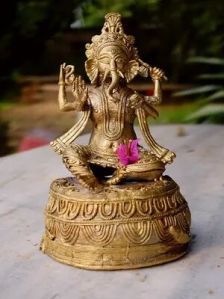
Lord Ganesha Dokra figurines
A have an assortment of Dokra artwork products that are produced with meticulousness and sincerity by or local artists whose divine hands craft these wonderful pieces of art. These figurines are enough to create a special ambience in your interior and take us back to those ancient times when our ancestors first created them. Give them a place in your interiors and see the difference they make in terms of aesthetics and authenticity. Your friends would definitely show fondness towards these creations and would admire your penchant for art. Our products include statuettes of Hindu Gods, Goddesses, figurines of animals, caskets, ashtrays, wall hangings, lamps and traditional tribal jewellery. Since ancient times, the people of India consider these art forms as auspicious. It is believed that keeping them at home or gifting them to someone brings good fortune to the families. Care should be taken with the statuettes of Hindu Gods and Goddesses who should be placed with reverence on a clean place; according to eastern beliefs, keeping statuettes of Gods and Goddesses is auspicious that bring peace and harmony in your family. We have various statuettes of Lord Krishna, Lord Ganesha, Goddess Parvati and Goddess Lakshmi whom you can place at home for inner peace and tranquillity. Dokra artefacts have immense value for aesthetes of handicrafts and for all those who hold handcrafted items in high esteem. Give a touch of uniqueness to your gifts, gift Dokra Art figurines to your loved ones and friends and see their faces shine up with glee! Our entire spectrum of Dokra artwork items are at your disposition….
...more
jute laundry baskets
Locally procured, locally craftedReusable, heavy duty, 100% naturalHand-crafted, durable, eco-friendly and biodegradableStylish design with two handles for easy mobilityAvailable in round and rectangular shapesImprints made with 100% natural dyesColours and designs available on demandHand wash in cold water only, vacuum or dry clean SIZE: 40cmH x 40cmD. Volume: 54 Litres 36cmL x 36cmW x 44cmH. Volume: 45 Litres Our laundry baskets are made of 100% jute that’s handcrafted with utmost care by our skilled craftsman. These laundry baskets are great not only in storing your everyday used laundry, but it also gives that bohemian touch to your home as jute as a product has a rustic appeal, that merges perfectly with all kinds of interiors. Due to the natural colour of jute which is an earthy tone, it has its own charm and appeal. Jute being an eco-friendly product, these baskets are 100% biodegradable leaving minimal carbon footprint. This makes jute products an inseparable part of our daily activities. The handles on both sides are also made of jute and they’re strong enough to help you effortlessly move the basket from one place to another. The basket has sufficient space for your used and dirty laundry which can be stored inside. The inner surface of our laundry baskets is moisture resistant fitted with a waterproof PE coating lining so that you can store dry as well as wet laundry in them. Being moisture resistant, they are more durable and last longer too. If you want to use your laundry basket for some other purpose e.g. storing and organizing clothes, children’s toys, pet grooming accessories, art and craft materials, baby clothing, diapers, etc. in them then you can do so as well. In addition, it has a cover that can be put on top to prevent dust from entering your basket. They can be washed easily by hand with cold water and mild detergent; otherwise they can be vacuumed or dry-cleaned. Our baskets are foldable and fully collapsible and you can stow them when not in use.
...more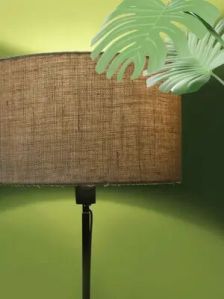
Lampshades Made Of Jute Fabric
Locally procured, locally craftedReusable, heavy duty, 100% natural jute lampshadeHand-crafted, durable, eco-friendly and biodegradablePerfect for home decorCan be fitted to tall floor lamps or bedside table lampsColours available on demandHand wash in cold water only, vacuum or dry clean SIZE: 41 cm L x 41cm B x 25 cm H 22.8 cm L x 20.32 x 10 cm H The jute we used in our lampshades is 100% natural that are procured locally. Our jute lampshades define the taste and sophistication that you want to add to your home decor and they enhance the trendiness of your interiors; choose our range of lampshades which are available in various shades and shapes that complement your mood. Jute lampshades are a perfect blend of rusticity and royalty that contributes uniqueness to the overall ambience to your rooms. They go exceptionally well with our range of our burlap cushion covers; there’s no denying the fact that your friends and relatives would go gaga over your keen eye for unparalleled elegance when you add them to your home decor! Being a natural fibre, jute is easy to maintain. It stays unaffected year after year and continues providing your interiors that distinguished look which is admired by all you friends and relatives calling on you. Occasionally jute might have random blemishes which are quite natural; these blemishes add on to their unique embellishment on the whole. We offer a variety of shapes and sizes of lampshades to choose from – conical, oval, cylindrical and rectangular. We use steel frames with epoxy coating on them that ensures higher durability and environment friendly. Also these frames are easy to clean and have a higher resistance to corrosion and degradation that make them last longer.
...more
Kantha Stitch Saree
The distinguished art of Kantha stitch has its roots in the pre-Vedic period (before 1500 BCE) and over centuries have flourished in West Bengal and Odisha. This is one of the traditional arts of West Bengal, Bihar and Odisha and is a manner of self-expression of the womenfolk of these regions. This heirloom is passed on from mothers to their daughters. Motifs and symbols of the art of the primitive times have made their way in the Kantha stitch artworks like trees, animals, fishes, folk scenes, tales of heroism, imageries of rural life, the cosmos, the sun and many more. In West Bengal this art is practiced by our women artists living mainly in the districts of Birbhum, North 24 Parganas, South 24 Parganas, Bardhaman, Hoogly and Murshidabad.Kantha as an art form was practiced only by the womenfolk who were mainly from the rural background. It was as popular among well-to-do families of the villages as it was among the necessitous ones. Kantha stitch art is a veritable example of imagination, ingenuity, assiduity and artistry of our women artisans. Concomitantly it also shows their inclination towards frugality and leading a sustainable way of livelihood. Kantha refers to the technique of embroidering or stitching as well as the final piece of work. It’s believed that the word Kantha has its roots in the Sanskrit word Kontha which means rug or patched cloth. It all started in the province of West Bengal, India where womenfolk took the initiative reusing old and worn-out pieces of fabric and threads instead of discarding them. They would take some of their used sarees, place one on top of another and create different running stitches on them. The idea was to use old fabric materials and give them a new life. They were usually used as blankets to cover themselves and swaddle their children with. Old pieces of clothes were cut into square and rectangle forms on which the womenfolk embroidered using threads that were naturally dyed –for dyeing madder and indigo were their first preference. These pieces of fabric were used to stitch quilts and wrappings. Each piece of Kantha has its own memories and tales to narrate as these pieces of heirloom art are created, used, shared, repaired and then reused. Kantha stitch artworks are gifted during wedding ceremonies, during Shasti Puja (a puja performed for conceiving), and also during Annaprasana (a ritual of feeding solid food to a child for the first time). Numerous varieties of stitching patterns are used by our women artists to stitch the Kantha, however the most common of them all is the running stitch that gives a dotted effect on both the sides throughout the entire layer of the fabric, renering the fabric a slightly wrinkled effect. Some other kinds of stitches are Shujni Kantha (for bedcovers), Baiton Kantha (used for covering books and valuable articles, Ooar Kantha (used on pillow covers), Lep Kantha (used for making warm, soft quilts), Durjani Kantha (a square piece of Kantha with a central lotus motif, used for covering inside of wallets), Arshilata Kantha (narrow embroidered Kantha used to store combs, small mirrors and other toiletries and Rumal Kantha (used as absorbent wipes or plate covering). Applique works and cross stitchs are also quite common on Kantha. Mandala (a circular figure representing the universe in Hindu and Buddhist symbolism) and Kalasha (metal pitcher with a wide belly and a narrow mouth used in Hindu rituals) are two widely use traditional patterns used by the artists on Kantha.The Kantha stitch art is a 100% sustainable form of art as it’s made entirely with human effort with the least possible raw materials; in fact it’s a novel way of reusing materials and exerts the least possible burden on our planet. The only devices that are required are a pair of scissors, used threads, old fabric material, needles and thimbles and proper lighting.With local assistance as well as with patronage from the state and the central government, the women artists of West Bengal have taken this art form to an altogether different dimension by introducing newer styles and designs and made this art even more presentable to acceptable to the world. They have ensured the entry of Kantha stitch in the world of fashion and today Kantha stitch is used widely on sarees, stoles, jackets, various Indian ethnic wears as also other home décor items like purses, cushion covers, wall hangings etc. that has become a style statement for many Indians and foreigners. Nowadays our artists experiment with motifs and patterns from all around the world like pop art, Egyptian mural art and varied types of designer patterns. The art has been successful in curving a niche for itself in the international market and designers from different part of the globe have incorporated the designs and patterns of our artisans in their works.Express your solidarity towards our women artists, use our Kantha stitch materials and help them fulfil their dreams. Their hard work would pay off when you use their handmade works of art.
...more
Kantha Stitch Potli Bag
The distinguished art of Kantha stitch has its roots in the pre-Vedic period (before 1500 BCE) and over centuries have flourished in West Bengal and Odisha. This is one of the traditional arts of West Bengal, Bihar and Odisha and is a manner of self-expression of the womenfolk of these regions. This heirloom is passed on from mothers to their daughters. Motifs and symbols of the art of the primitive times have made their way in the Kantha stitch artworks like trees, animals, fishes, folk scenes, tales of heroism, imageries of rural life, the cosmos, the sun and many more. In West Bengal this art is practiced by our women artists living mainly in the districts of Birbhum, North 24 Parganas, South 24 Parganas, Bardhaman, Hoogly and Murshidabad.Kantha as an art form was practiced only by the womenfolk who were mainly from the rural background. It was as popular among well-to-do families of the villages as it was among the necessitous ones. Kantha stitch art is a veritable example of imagination, ingenuity, assiduity and artistry of our women artisans. Concomitantly it also shows their inclination towards frugality and leading a sustainable way of livelihood. Kantha refers to the technique of embroidering or stitching as well as the final piece of work. It’s believed that the word Kantha has its roots in the Sanskrit word Kontha which means rug or patched cloth. It all started in the province of West Bengal, India where womenfolk took the initiative reusing old and worn-out pieces of fabric and threads instead of discarding them. They would take some of their used sarees, place one on top of another and create different running stitches on them. The idea was to use old fabric materials and give them a new life. They were usually used as blankets to cover themselves and swaddle their children with. Old pieces of clothes were cut into square and rectangle forms on which the womenfolk embroidered using threads that were naturally dyed –for dyeing madder and indigo were their first preference. These pieces of fabric were used to stitch quilts and wrappings. Each piece of Kantha has its own memories and tales to narrate as these pieces of heirloom art are created, used, shared, repaired and then reused. Kantha stitch artworks are gifted during wedding ceremonies, during Shasti Puja (a puja performed for conceiving), and also during Annaprasana (a ritual of feeding solid food to a child for the first time). Numerous varieties of stitching patterns are used by our women artists to stitch the Kantha, however the most common of them all is the running stitch that gives a dotted effect on both the sides throughout the entire layer of the fabric, renering the fabric a slightly wrinkled effect. Some other kinds of stitches are Shujni Kantha (for bedcovers), Baiton Kantha (used for covering books and valuable articles, Ooar Kantha (used on pillow covers), Lep Kantha (used for making warm, soft quilts), Durjani Kantha (a square piece of Kantha with a central lotus motif, used for covering inside of wallets), Arshilata Kantha (narrow embroidered Kantha used to store combs, small mirrors and other toiletries and Rumal Kantha (used as absorbent wipes or plate covering). Applique works and cross stitchs are also quite common on Kantha. Mandala (a circular figure representing the universe in Hindu and Buddhist symbolism) and Kalasha (metal pitcher with a wide belly and a narrow mouth used in Hindu rituals) are two widely use traditional patterns used by the artists on Kantha.The Kantha stitch art is a 100% sustainable form of art as it’s made entirely with human effort with the least possible raw materials; in fact it’s a novel way of reusing materials and exerts the least possible burden on our planet. The only devices that are required are a pair of scissors, used threads, old fabric material, needles and thimbles and proper lighting.With local assistance as well as with patronage from the state and the central government, the women artists of West Bengal have taken this art form to an altogether different dimension by introducing newer styles and designs and made this art even more presentable to acceptable to the world. They have ensured the entry of Kantha stitch in the world of fashion and today Kantha stitch is used widely on sarees, stoles, jackets, various Indian ethnic wears as also other home décor items like purses, cushion covers, wall hangings etc. that has become a style statement for many Indians and foreigners. Nowadays our artists experiment with motifs and patterns from all around the world like pop art, Egyptian mural art and varied types of designer patterns. The art has been successful in curving a niche for itself in the international market and designers from different part of the globe have incorporated the designs and patterns of our artisans in their works.Express your solidarity towards our women artists, use our Kantha stitch materials and help them fulfil their dreams. Their hard work would pay off when you use their handmade works of art.
...moreBe first to Rate
Rate ThisOpening Hours